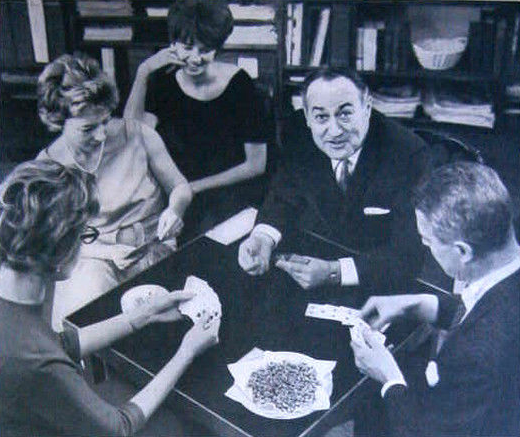Source: www.si.com January 30, 1961

Lee Hazen, a New York lawyer, is frequently quoted in bridge columns, and with very good reason, for he has been one of this country’s most respected players for more than twenty years.
He also is a talented raconteur. One of his favorite stories is about a player who finessed against both of the defenders for a missing queen and won both finesses. His first finesse was through Hazen up to dummy’s ace-10-small. Since Hazen had the queen, this finesse succeeded. Several tricks and many minutes later, declarer led a low card from the board up to his own king-jack. He played the jack, and Hazen immediately and erringly followed with a small card rather than his queen. As Hazen put it, «The only question about this hand was which was worse, declarer’s memory or my eyesight.»
Recently Hazen came up with a new twist to the two-way finesse. He calls it «the two-way non-finesse.» The way the bidding went will require a little explaining, but this was the deal:
Neither side vulnerable South dealer
Opening lead: queen of spades
Hazen was South, and let him explain his three-diamond bid himself. «I can only tell you that my partner plays what you might term a flexible two no trump. That bid could have meant that he just did not like either of my suits, or that if we were going to play the hand at no trump he would like to have had the fun of being declarer. Anyway, we got to within one trick of our best contract when North bid five clubs. We could have made six in that suit.»
I cannot say that this is a perfectly satisfactory justification of South’s rebid of his four-card suit, but that action did lead to an interesting contract.
At first glance Hazen’s problem, namely, how to win 11 tricks at diamonds, appeared to hinge on guessing which opponent held the queen of diamonds, but declarer made the hand by playing both opponents for that card.
South won the first trick with the king of spades, cashed the ace of clubs and the ace-king of hearts, then led a spade to dummy’s ace. He ruffed a low club with the 8 of diamonds and trumped his remaining spade with dummy’s diamond 7 when West showed out, discarding a club.
A third round of clubs was trumped with the diamond 9, dropping West’s king. The stage was now set for the double no-finesse. South led a low heart and trumped it with dummy’s ace of diamonds. Then he led another club and trumped that one with his diamond king.
South now had 10 tricks home, and a heart lead, trumped with dummy’s 10 of diamonds, was bound to produce the 11th. Either it would win that trick or it would establish South’s jack when, as was the case, East overruffed.
By maneuvering as he did, declarer insured the contract no matter where the diamond queen lay. As you will observe, if he had risked an overruff with the diamond queen by either defender, a trump return would have beaten him. His line of play precluded this defense.
EXTRA TRICK
The next time you are faced with a two-way finesse for a missing queen, stop and think. The solution of your problem may be the two-way non-finesse. That is, you may be able to allow for the queen to be in both defenders’ hands. Simply by counting the tricks you most likely will win without finessing at all.
